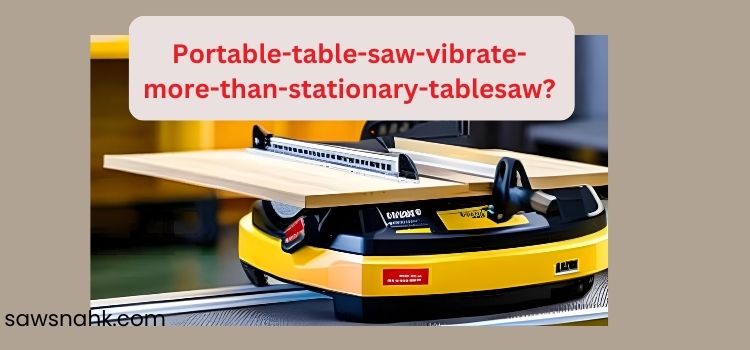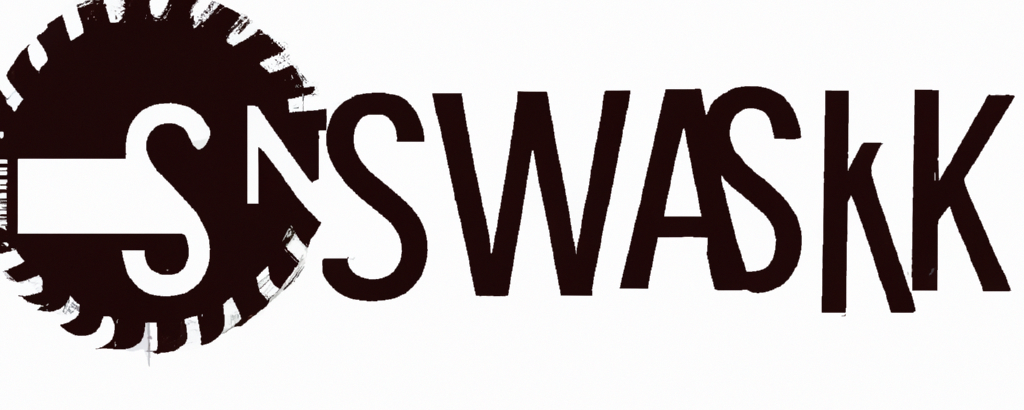Why does a portable table saw vibrate more than stationary table saws?

A portable table saw vibrates more than a stationary table saw due to its lightweight, smaller size, direct motor mounting, and lighter base. These vibrations may eventually lead to inaccurate cuts, safety risks, wear and tear of the blades, kickbacks, and even fatigue.
So, addressing and minimizing these vibrations is necessary to reduce all the above risks in a portable table saw. But the issue is: how to reduce the vibrations of a table saw? You can do this with a stable worktable, a prominent blade setup, and vibration-absorbing accessories.
But all this is not as straightforward as it sounds. So, let’s address the root causes of a portable vibrating table saw, its consequences, and steps to reduce this issue. Keep reading!
What Causes Higher Vibrations in Portable Table Saw than Stationary Table Saw?
For certain reasons, a portable table saw tends to vibrate more than its counterpart, i.e., a stationary table saw. Here are the most prominent factors that contribute to this issue;
Light Weight of Portable Table Saw
You know that portable table saws are smaller and tend to be lightweight compared to stationary ones. But the cutting process creates heavy vibrations not absorbed by the portable saw due to its compact size and less weight. So, it’s one of the major causes of higher vibrations in a portable table saw.
Components Material
Manufacturers use lightweight materials, like plastic or aluminum, in portable table saws to make them easy to carry. However, these materials tend to be very lightweight but are not as rigid as iron or steel. So, the reduced rigidity leads to increased vibrations in table saws.
Direct Motor Mounting
The motor of a portable table saw is directly connected to the blade arbor, and this design is called a direct-drive motor configuration. This configuration assists in the portable design of the table saw but leads to increased vibrations. The motor vibrations are directly transferred to the blade, leading to increased shaking when cutting wood with a portable table saw.
Lighter Trunnions
Unlike stationary table saws with sturdy trunnions and base support, portable table saws have lighter trunnions and supports. The heavy-duty base and support of the stationary saws absorb most of the vibrations, making them relatively stable and less shaky. On the contrary, the lighter support and base of the portable saw hardly absorb any vibrations, making them shaky when carrying out cutting procedures.
Dull Blade
Blade quality and conditions also contribute a lot to the overall performance of any saw. Dull or improperly aligned blades can cause excessive vibrations as they struggle to make clean cuts. Possibly, it can be a reason for your shaky portable table saw.
Poor Fence Stability
Portable table saws often have lighter and less rigid fences than stationary models. So, a less stable fence can result in increased vibrations as it may not hold the workpiece securely during cutting, causing movement and shaking.
Miter Gauge Design Concern
Portable table saws have a simple and less robust miter gauge that may have more play or wiggle, leading to vibrations and imprecise cuts. You’ll encounter higher vibrations, especially when working with longer or heavier workpieces.
Improper Anti-Vibration Features
Stationary table saws often have built-in anti-vibration mechanisms, like rubber feet or pads, that help absorb and reduce vibrations. Portable table saws usually lack these anti-vibration features that may contribute to transmitting vibrations to the work surface.
Tabletop Material
Stationary table saws frequently have solid and heavy-duty tabletops. These are usually made of sturdy materials like cast iron, which offer superior stability and vibration dampening. On the other hand, portable table saws commonly have lighter tabletops. These feature aluminum or plastic materials, less effective at minimizing vibrations.
Limited Cutting Capacity
Portable table saws typically have smaller motors and are designed for lighter-duty tasks than stationary ones. So, when you use them to cut through denser or harder materials, a portable saw’s lower power and torque can lead to increased vibrations.
What are the Consequences of a Vibrating Portable Table Saw?
A portable vibrating table saw creates different issues; sometimes, the consequences may be severe. Here are the most prominent risks of working with a shaky portable table saw;
Faulty Cuts
Increased vibrations and shaking of a portable saw may not lead the blad properly through the intended path. It may result in wavy and uneven cuts. Such cuts may make the cut pieces poorly fit their counterparts, thus resulting in the wastage of material.
Increased Kickbacks
A shaky portable table saw is risky and may pose certain security issues. The most prominent risk of such a cutting machine is forceful kickback, which may lead to potential injuries.
Wearing and Tearing of Materials and Saw Components
The increased vibrations during the cutting process may result in unnecessary chipping and wearing out of the material. Moreover, cutting with such a tool will pose additional force on the motor, thus resulting in premature wearing and tearing of the saw parts.
Increased Fatigue
To control the vibrations and ensure the quality cuts, the operator must invest his energy. It will lead to increased fatigue and discomfort, decreasing proficiency.
Poor Surface Finish
The vibrations of the portable table saw may lead to unnecessary marks on the cutting surface. So, you can’t achieve “that” finish when cutting with a shaky ripping machine, eventually leading to a poor surface finish.
How Can One Modify the Portable Table Saw to Have Reduced Vibrations?
After reading the above-listed consequences of a portable vibrating table saw, you’ll have got why it is crucial to address and minimize these vibrations. It will ensure accurate cuts, enhance safety, maintain cutting efficiency, preserve the longevity of the saw, and provide a more comfortable working environment. Here are some effective steps to reduce the vibrations on a portable table saw;
Use a Stable Workbench
To minimize the risks of a shaky portable table saw, set up your saw on a stable work table. It’s properly leveled and sturdy enough to absorb the resulting vibrations. Moreover, add support to the base of your ripping machine to make it less shaky.
Maintain the Blade Quality and Conditions
Ensure you’re using the right portable table saw blade for your projects. Moreover, keep sharpening the blade to keep it in shape and avoid unnecessary vibrations and shaking. Also, check the miter gauge and blade alignment, as these are also the culprits of a shaky saw.
Install Anti-Vibration Accessories
Using anti-vibration accessories, like rubber mats or vibration isolators, will also help reduce vibrations on your portable table saw. You can place them between the table saw and the work surface to absorb and reduce vibrations.
Workpiece Mounting
Ensure you have properly mounted the workpiece to the work table to avoid wobbliness or shaking. You can use clamps to secure the workpiece to the table to prevent movement or vibration of the workpiece, which can contribute to overall vibrations in the saw.
Avoid Overloading
Before using your portable table saw, read its user manual carefully to understand its power and capability. Having an idea about its capabilities, avoid overloading it. It will also help in reducing the vibrations.
Maintain the Portable Table Saw Properly
Be sincere to your working partner and pay attention to its cleaning and maintenance concerns. Clean and clear all the dust and debris after each cutting session. It will reduce the vibrations on your portable table saw and add to its life.
Conclusion
In conclusion, why does a portable table saw vibrate more than a stationary table saws? A portable table saw vibrates more due to its lighter weight, lightweight parts, compact size, lighter base, and less powerful motor. Moreover, overloading your portable table saw also leads to increased vibrations.
Such a shaky cutting tool can prove very risky, so addressing and controlling the vibration causes is necessary. You can reduce the shaking of a portable table saw by using vibration-dampening accessories, adding additional support to the base, and avoiding overloading it. Hopefully, this guide will help you make your cutting procedures smooth and safe. Enjoy your woodworking projects!
FAQs
Why is my table saw vibrating?
A table can vibrate due to poorly aligned or dull blades, loose arbor flanges, overloading, poorly balanced worktable, etc. Moreover, when you don’t secure the workpiece to the table, it will lead to a shaky portable table saw.
What is a stationary table saw?
A stationary table saw is a larger, more powerful type of table saw intended for permanent installation in a workshop or any other dedicated space. It features a larger table, a more robust construction, and a powerful motor. Such a saw offers greater stability and cutting capacity to work on larger projects. Professional woodworkers and artisans commonly use stationary table saws for heavy-duty cutting tasks.
What is a portable table saw used for?
You Can Use A Portable Saw For Various Woodworking Tasks Like Cross-Cutting, Ripping, Bevel Cuts, And Mitering Various Materials. You Can Use Them To Cut Different Materials, Including Wood, Plywood, And Certain Plastics. Such A Saw Is Compact And Lightweight And Is Ideal For Job Sites Or Workshops Where Mobility Is A Priority.
